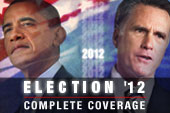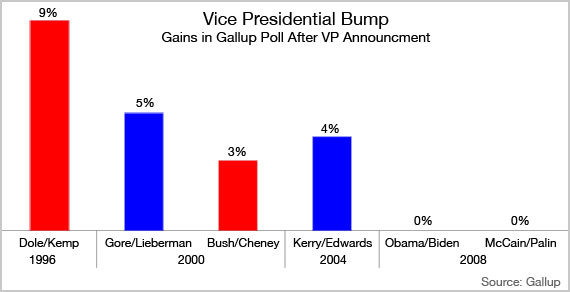With less than 100 days before the election, presumptive Republican presidential nominee Mitt Romney should get a useful bump in the polls shortly after he announces his choice for a vice presidential running mate, if history is any guide.

Whether he settles on a predictable and safe choice – such as Sen. Rob Portman of Ohio, former Minnesota Governor Tim Pawlenty Sen. Marco Rubio of Florida – or a more daring choice such as Sen. Kelly Ayotte of New Hampshire, Romney is almost certain to get up to a five-point boost in his standing against President Obama, according to an analysis of Gallup polling dating back to 1996.
In a race so excruciatingly close, any minor advantage can help. A Wall Street Journal/NBC News poll released last week found Obama holding a modest 49 percent to 43 percent lead over the former Republican Massachusetts governor, a gap mirrored precisely in four other Journal/NBC polls over the last year. According to the latest Gallup tracking polling, Obama and Romney are deadlocked, 46 percent to 46 percent.
Over the weekend, Romney sought to beef up his modest foreign policy credentials by meeting in Jerusalem with Prime Minister Benjamin Netanyahu and other Israeli officials while one of his senior foreign policy advisers said Sunday that Romney would support a unilateral military strike by Israel against Iran to stop Tehran from obtaining nuclear weapon capability. At the same time, the Obama campaign held thousands of events across the U.S. aimed at mobilizing volunteers.
The final three months of the campaign will be heavily influenced by a number of events besides Romney's vice presidential choice. Those include the two campaigns running hundreds of millions of dollars worth of negative TV ads in 10 or so key battleground states, the two national conventions scheduled around Labor Day, three nationally televised presidential debates, one vice presidential debate beginning in early October, and four monthly Labor Department reports on the unemployment rate before Election Day on Nov. 6.
Almost every Republican and Democratic presidential nominee going back at least 16 years received a bump in the polls immediately after announcing his choice for vice president.

Democratic presidential nominee John F. Kerry, a senator from Massachusetts, saw his numbers jump by four percentage points after he picked Sen. John Edwards of North Carolina in 2004. Four years earlier, then Republican presidential nominee George W. Bush enjoyed a three-point bounce after hand picking former Defense Secretary Dick Cheney as his running mate. And then-Sen. Bob Dole of Kansas scored an extraordinary nine point bump after choosing former Housing Secretary Jack Kemp as his vice presidential running mate in 1996. That proved to be Dole’s high water mark in his unsuccessful campaign against Democratic President Bill Clinton.
Jeffrey Jones, managing editor of Gallup polls, said last week that vice presidential picks have generally proven to be an overall plus for a presidential nominee, regardless of party. “I think the dynamic is that it becomes the dominant news story and people look favorably on the presidential candidate for making the choice in most cases,” Jones told The Fiscal Times. “So that positive attention definitely helps.”
But not always. Democratic presidential nominee Barack Obama picked Sen. Joseph Biden, D-Del., as his running mate on August 23, 2008, just before the Democratic National Convention, and got no appreciable bump in the polls. Gallup Poll daily tracking August 23-25 showed Republican Sen. John McCain of Arizona holding a 46 percent to 44 percent advantage over Obama, which was statistically similar to the 46 percent to 44 percent Obama advantage August 20-22, according to Gallup’s Jones.
And contrary to popular assumptions, McCain’s choice of then-Alaska Governor Sarah Palin did not provide him with an instant surge in the polls. McCain announced his surprise choice of the little known Palin in late August, immediately following the Democratic convention and just before the Republican National Convention. The two then made a series of joint appearances to fire up the conservative base and heighten media interest in the GOP convention, which opened a few days later in St. Paul, Minn.
McCain ultimately benefitted in the polls from the combination of his choice of Palin and what turned out to be a highly successful convention in which McCain stressed his foreign policy and national security credentials and Palin wowed the crowds with her straight-talking conservative rhetoric.
A Sept. 8 USA-Today-Gallup poll showed McCain ahead of Obama, 50 percent to 46 percent, among registered voters – which represented McCain’s biggest advantage since that January. It was also a turnaround from the USA Today poll taken just before the Republican convention opened, when McCain lagged behind Obama by seven percentage points.
But a closer examination of the data showed that McCain did not get an immediate bump from his choice of Palin, who until then was a relatively obscure first term governor. Gallup’s daily tracking August 26 through 28, the three days before McCain picked Palin, showed Obama leading McCain, 49 percent to 41 percent, among registered voters. The tracking poll results for the three days immediately after Palin was chosen, August 29 through 31, showed Obama still ahead, 49 percent to 43 percent. No significant change there.
“The simple event of McCain picking Palin didn’t affect anything,” Jones said. “But over the course of that week, his acceptance speech, possibly her speech, and just the buzz and excitement around the Republican ticket . . . that all contributed to him getting a bump.”
Larry Sabato, a University of Virginia political scientist, said generalizations are difficult on the impact of the vice presidential choice. It always depends on who is selected, what his or her pluses and minuses are, and what the circumstances of the election year are, he said.
“But I think it’s fair to say that the more polarized the environment, the less likely a VP pick will rearrange the polling landscape,” he said. “We are in such an environment in 2012. Whatever temporary national polling bump occurs for Romney is unlikely to prove permanent. But again, I have to see the choice. There may be an exception or two we are not thinking about just now.
Sabato added that: “We’re more likely to conclude that Romney’s candidate didn’t HURT him. He may well be leaning to a safe choice.”
And even a safe choice can help in a particular state. For example, it’s possible that Portman could add a percent or two to Romney in Ohio, a key battleground state, if Portman is put on the ticket. Lyndon B. Johnson helped Democrat John F. Kennedy win the 1960 presidential election by delivering Texas to their Democratic ticket.
While just about nobody believes that the choice of a running mate can change the course of a campaign, it can provide at least a momentary surge in momentum and media interest, or reassurance to voters that a presidential nominee has forged a strong or well experienced ticket.
When he ran the first time for president in 2000, Bush, the Texas governor, compensated for his lack of foreign policy and national security experience by putting Cheney on his ticket. Former Vice President Al Gore strengthened his appeal to moderate and swing voters by putting Sen. Joseph Lieberman of Connecticut on his Democratic ticket in 2000.
Assessing the political impact of the choice of a running mate can be a challenge, especially when the announcement comes shortly before the national convention or – as was the practice years ago – during the convention. Former California governor Ronald Reagan chose George H.W. Bush as his running mate at the 1980 Republican National Convention, a last-minute development that caught delegates by surprise. In 1976, President Gerald Ford announced his choice of Dole as his running mate on the last day of the convention, in a bid to patch things up with the conservatives.
Jones said that it’s impossible to go back before 1996 to discern vice presidential bumps in the polls because of the paucity of relevant polling tracking data and the fact that the choices were made too close to the conventions, or at the convention. “You’re getting into territory where they’re happening right on top of the convention or during the convention, and we don’t have enough polls – or enough space between the polls – where we can kind of isolate the effect of the choice,” he said.





